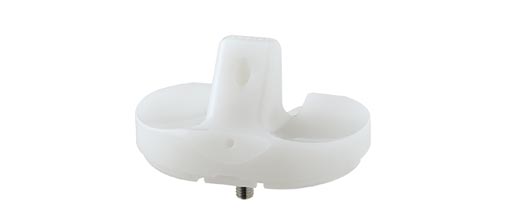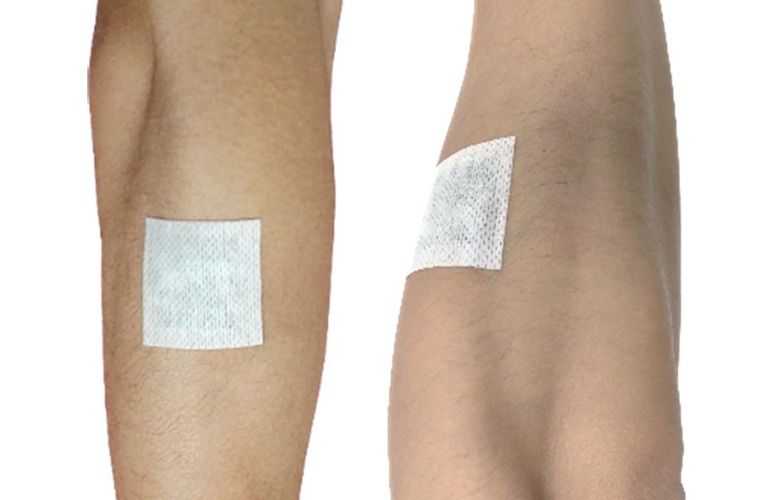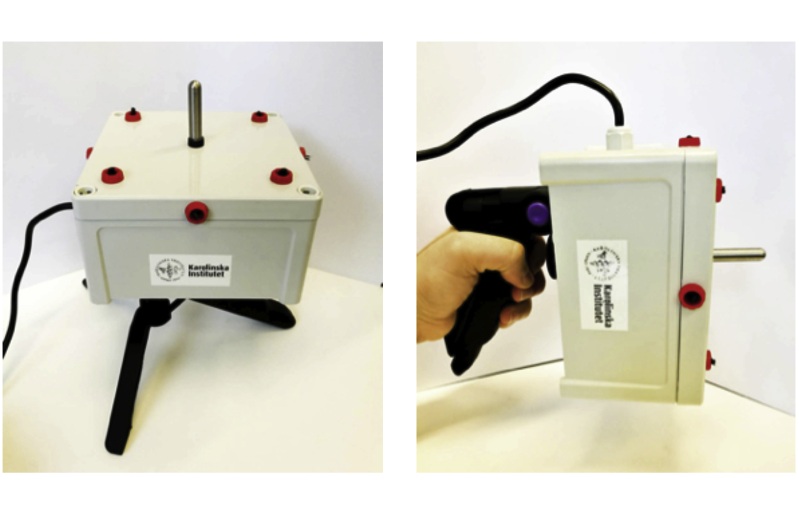Polyethylene Knee Insert Reduces Oxidation Risk
|
By HospiMedica International staff writers Posted on 26 Apr 2017 |

Image: The E-XPE knee arthroplasty insert in PSA configuration (Photo courtesy of UOC).
A novel knee insert made of highly cross-linked polyethylene blended with vitamin E enhances wear resistance, without compromising oxidative stability and mechanical properties.
The E-XPE insert is indicated in knee arthroplasty for reduction or relief of pain and/or improved knee function in skeletally mature patients with severe knee pain and disability due to rheumatoid arthritis (RA), osteoarthritis (OA), primary and secondary traumatic arthritis, polyarthritis, collagen disorders, avascular necrosis of the femoral condyle, pseudo-gout, and post-traumatic loss of joint configuration, among others. It may also be indicated in the salvage of previously failed surgical attempts, if the knee can be satisfactorily balanced and stabilized at the time of surgery.
The single use insert is made of highly cross-linked polyethylene blended with 0.1% vitamin E, which is intended to reduce the oxidation caused by free radical generated during the sterilization irradiation process and the thermal treatment of the polyethylene insert. The E-XPE insert is a product of United Orthopedic Corporation, is available in CR, PS, UC, PSA, and patella configurations, and has been approved by the U.S. Food and Drug Administration (FDA).
“Oxidation continues to be a concern for surgeons. The E-XPE polyethylene is resistant to oxidation and performs extremely well with respect to abrasive wear resistance,” said Calvin Lin, President of United Orthopedic Corporation. “Our E-XPE polyethylene knee insert represents an important milestone in our knee portfolio.”
The majority of knee replacements consist of metal femoral and tibial components with a polyethylene liner inserted between the two articulating surfaces. Although designed to withstand the substantial forces that are transmitted across the knee joint during everyday activities, the friction generated by the articulating surfaces results in wear of the plastic liner, releasing small particles of polyethylene that activate the body’s immune system, triggering an inflammatory response and causing the bone around the knee replacement to be reabsorbed. The result is that the knee replacement becomes loose and painful, known as aseptic loosening.
The E-XPE insert is indicated in knee arthroplasty for reduction or relief of pain and/or improved knee function in skeletally mature patients with severe knee pain and disability due to rheumatoid arthritis (RA), osteoarthritis (OA), primary and secondary traumatic arthritis, polyarthritis, collagen disorders, avascular necrosis of the femoral condyle, pseudo-gout, and post-traumatic loss of joint configuration, among others. It may also be indicated in the salvage of previously failed surgical attempts, if the knee can be satisfactorily balanced and stabilized at the time of surgery.
The single use insert is made of highly cross-linked polyethylene blended with 0.1% vitamin E, which is intended to reduce the oxidation caused by free radical generated during the sterilization irradiation process and the thermal treatment of the polyethylene insert. The E-XPE insert is a product of United Orthopedic Corporation, is available in CR, PS, UC, PSA, and patella configurations, and has been approved by the U.S. Food and Drug Administration (FDA).
“Oxidation continues to be a concern for surgeons. The E-XPE polyethylene is resistant to oxidation and performs extremely well with respect to abrasive wear resistance,” said Calvin Lin, President of United Orthopedic Corporation. “Our E-XPE polyethylene knee insert represents an important milestone in our knee portfolio.”
The majority of knee replacements consist of metal femoral and tibial components with a polyethylene liner inserted between the two articulating surfaces. Although designed to withstand the substantial forces that are transmitted across the knee joint during everyday activities, the friction generated by the articulating surfaces results in wear of the plastic liner, releasing small particles of polyethylene that activate the body’s immune system, triggering an inflammatory response and causing the bone around the knee replacement to be reabsorbed. The result is that the knee replacement becomes loose and painful, known as aseptic loosening.
Latest Surgical Techniques News
- Superior Orthopedic Implants Combat Infections and Quicken Healing After Surgery
- Laser-Based Technique Eliminates Pancreatic Tumors While Protecting Healthy Tissue
- Surgical Treatment of Severe Carotid Artery Stenosis Benefits Blood-Brain Barrier
- Revolutionary Reusable Duodenoscope Introduces 68-Minute Sterilization
- World's First Transcatheter Smart Implant Monitors and Treats Congestion in Heart Failure
- Hybrid Endoscope Marks Breakthrough in Surgical Visualization
- Robot-Assisted Bronchoscope Diagnoses Tiniest and Hardest to Reach Lung Tumors
- Diamond-Titanium Device Paves Way for Smart Implants that Warn of Disease Progression
- 3D Printable Bio-Active Glass Could Serve as Bone Replacement Material
- Spider-Inspired Magnetic Soft Robots to Perform Minimally Invasive GI Tract Procedures
- Micro Imaging Device Paired with Endoscope Spots Cancers at Earlier Stage
- AI Spine Model Could Reduce Surgical Risks
- Novel Method Uses Interstitial Fluid Flow to Predict Where Brain Tumor Can Grow Next
- World’s First Custom Anterior Cervical Spine Surgery Performed Using Personalized Implant
- Implantable Biodegradable Scaffold Helps Broken Bones Regrow Quickly
- First Human Spinal Cord Repair Using Patient Own Cells Could Cure Paralysis
Channels
Critical Care
view channel
Highly Sensitive On-Skin Sensing Monitor Detects Vitamin B6 and Glucose in Sweat
Vitamin B6 plays a crucial role in immune function and brain health, yet patients with chronic conditions such as diabetes often experience deficiencies that can cause irritability, depression, anemia,... Read more
Artificial Intelligence Revolutionizing Pediatric Anesthesia Management
Administering anesthesia to children poses unique challenges, as their anatomy varies significantly even among patients of the same age. Misjudging the correct breathing tube size or failing to detect... Read morePatient Care
view channel
Revolutionary Automatic IV-Line Flushing Device to Enhance Infusion Care
More than 80% of in-hospital patients receive intravenous (IV) therapy. Every dose of IV medicine delivered in a small volume (<250 mL) infusion bag should be followed by subsequent flushing to ensure... Read more
VR Training Tool Combats Contamination of Portable Medical Equipment
Healthcare-associated infections (HAIs) impact one in every 31 patients, cause nearly 100,000 deaths each year, and cost USD 28.4 billion in direct medical expenses. Notably, up to 75% of these infections... Read more
Portable Biosensor Platform to Reduce Hospital-Acquired Infections
Approximately 4 million patients in the European Union acquire healthcare-associated infections (HAIs) or nosocomial infections each year, with around 37,000 deaths directly resulting from these infections,... Read moreFirst-Of-Its-Kind Portable Germicidal Light Technology Disinfects High-Touch Clinical Surfaces in Seconds
Reducing healthcare-acquired infections (HAIs) remains a pressing issue within global healthcare systems. In the United States alone, 1.7 million patients contract HAIs annually, leading to approximately... Read moreHealth IT
view channel
Printable Molecule-Selective Nanoparticles Enable Mass Production of Wearable Biosensors
The future of medicine is likely to focus on the personalization of healthcare—understanding exactly what an individual requires and delivering the appropriate combination of nutrients, metabolites, and... Read moreBusiness
view channel
Philips and Masimo Partner to Advance Patient Monitoring Measurement Technologies
Royal Philips (Amsterdam, Netherlands) and Masimo (Irvine, California, USA) have renewed their multi-year strategic collaboration, combining Philips’ expertise in patient monitoring with Masimo’s noninvasive... Read more
B. Braun Acquires Digital Microsurgery Company True Digital Surgery
The high-end microsurgery market in neurosurgery, spine, and ENT is undergoing a significant transformation. Traditional analog microscopes are giving way to digital exoscopes, which provide improved visualization,... Read more
CMEF 2025 to Promote Holistic and High-Quality Development of Medical and Health Industry
The 92nd China International Medical Equipment Fair (CMEF 2025) Autumn Exhibition is scheduled to be held from September 26 to 29 at the China Import and Export Fair Complex (Canton Fair Complex) in Guangzhou.... Read more













